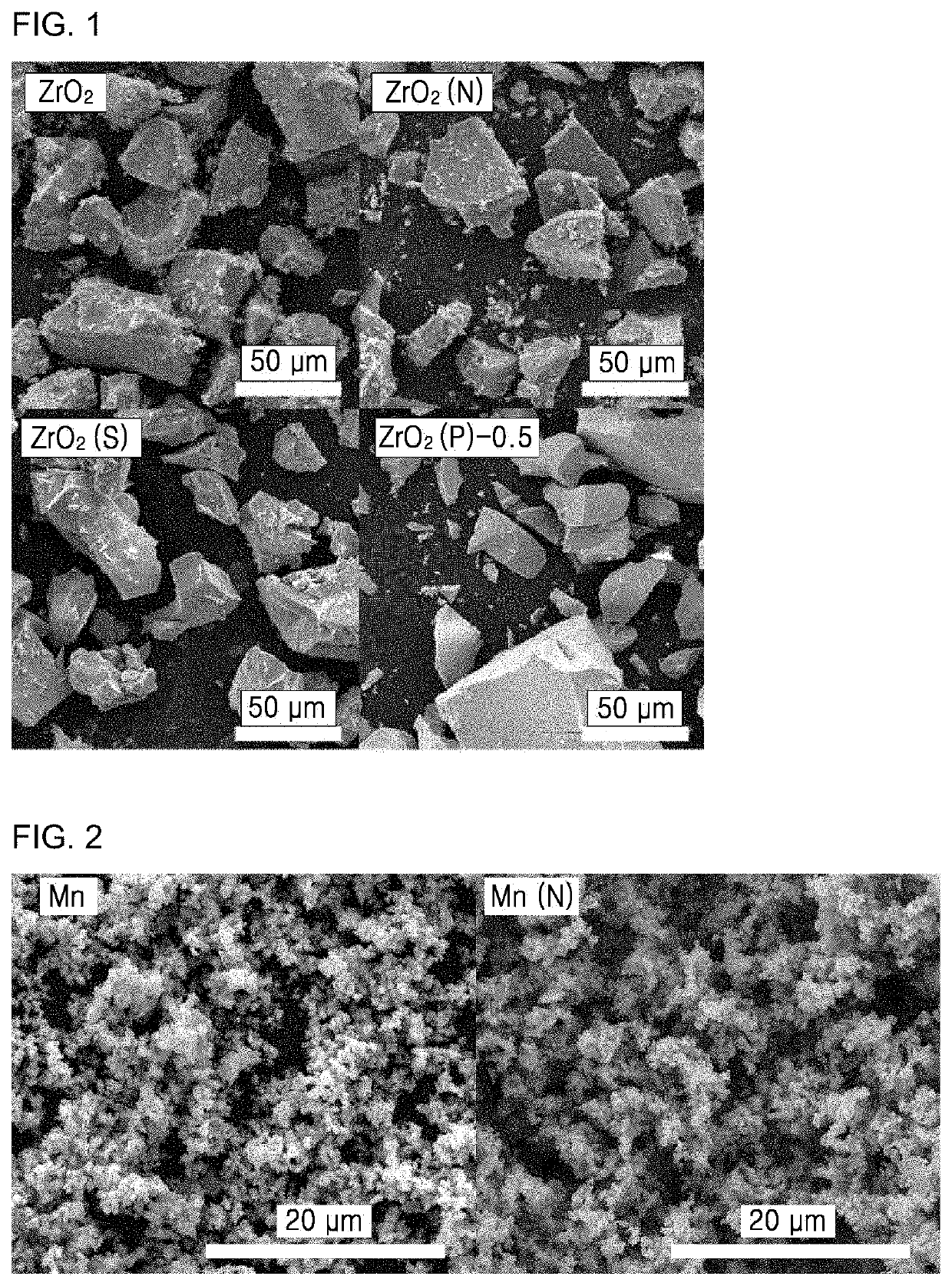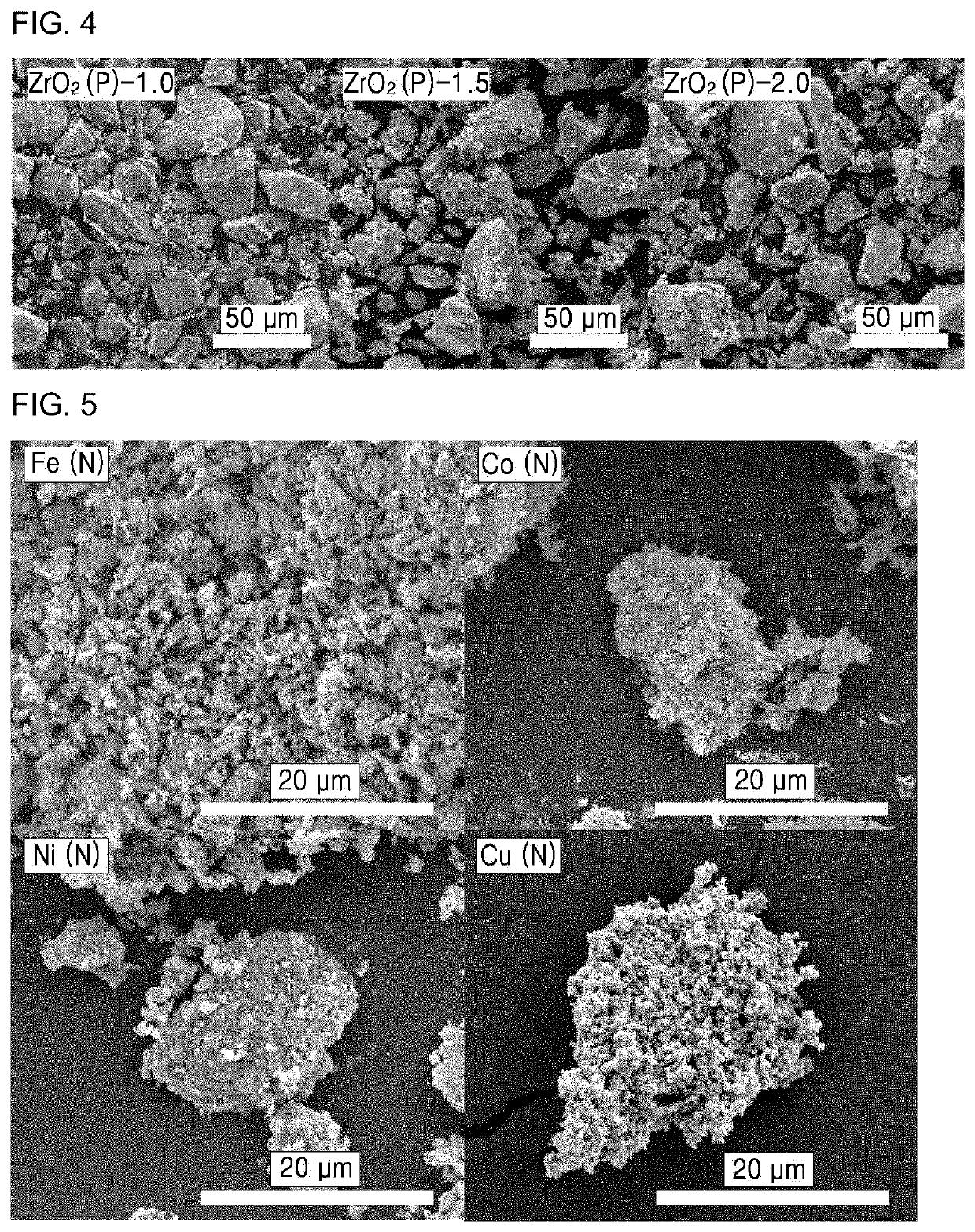Catalysts for fenton system containing metal oxide containing functional group on surface and fenton system using the same
a technology of fenton and functional group, which is applied in the direction of catalyst activation/preparation, metal/metal-oxide/metal-hydroxide catalyst, physical/chemical process catalyst, etc., can solve the problem of limiting the number of uses of the coated catalyst, limiting the decomposition rate of non-degradable organic materials by .oh, and limited the commercialization of the electro-fenton process for wastewater treatment. problem, to achieve the effect of wider
- Summary
- Abstract
- Description
- Claims
- Application Information
AI Technical Summary
Benefits of technology
Problems solved by technology
Method used
Image
Examples
examples
Examples 1 to 3: Preparation of ZrO2, ZrO2 (N), and ZrO2 (S) Catalysts
[0166]Porous and crystalline ZrO2 catalysts were prepared by hydrothermal synthesis. Specifically, 20 mmol of ZrOCl2.8H2O and 40 mmol of oxalic acid (C2H2O4.8H2O) were dissolved in 100 mL of distilled water, and the solution was stirred at 50° C. for 60 minutes, followed by drying and calcination at 400° C. for 2 hours. A catalyst prepared in Example 1 is referred to as ZrO2. The ZrO2 catalyst of Example 1 was placed in a reactor and exposed to nitrogen monoxide (NO) and oxygen (O2) diluted with N2 by simultaneously supplying them at a flow rate of 500 mL min−1 at ambient atmospheric pressure at 100° C. for 60 minutes, and then cooled to room temperature in a N2 atmosphere. In the exposure process, an amount of nitrogen monoxide was 5000 ppm and a volume of oxygen was 3 vol %. Under the conditions, a NO3−-functionalized catalyst according to Example 2 was prepared. Hereinafter, the catalyst of Example 2 is referre...
examples 20 to 23
(S), Co(S), Ni(S) and Cu(S) Catalysts
[0183]Porous and crystalline manganese oxide, cobalt oxide, nickel oxide, and copper oxide were prepared by templated synthesis. Specifically, 100 mL of an aqueous solution including 20 mmol of oxalic acid (C2H2O4.2H2O) and 20 mmol of MnSO4H2O / CoSO4.7H2O / NiSO4.7H2O / CuSO4.5H2O was stirred for 30 minutes at 50° C. The resultant was filtered / washed with distilled water and ethanol and dried at 70° C., followed by calcination at 300° C. for 1 hour to prepare manganese oxide, cobalt oxide, nickel oxide, and copper oxide. The prepared metal oxide was exposed to an atmosphere including 500 ppm of SO2 and 3 vol % of O2 diluted with N2 at a flow rate of 500 mL min−1 at 500° C. for 45 minutes, and then cooled to room temperature in a N2 atmosphere. A SO42−-functionalized catalysts prepared under the conditions are referred to as Example 20 (Mn(S)), Example 21 (Co(S)), Example 22 (Ni(S)) and Example 23 (Cu(S)), respectively.
[0184]The catalysts prepared in E...
experimental example 2
est
[0200](1) Electro-Fenton Reaction
[0201]An electro-Fenton reaction test was performed using the catalysts according to Examples 1 to 4 and Examples 29 to 33, a graphite electrode, phenol (C6H5OH) as an organic material, and a Na2SO4 aqueous electrolytic solution. When the catalysts were coated on the electrode, poly(vinylidene fluoride) (PVDF) was used as a binder. 0.2 g of the catalyst was used and 100 mL of an aqueous solution in which 0.1 mmol of phenol (NPHENOL,0) and 0.2 mol of Na2SO4 were dissolved was used as a reaction solution. The electro-Fenton reaction test was performed at 25° C. at a pH of 7 with a power of 0.04 W. A slope of a pseudo-1st-order kinetic fitting graph (−ln(CPHENOL / CPHENOL,0) VS. time) obtained based on a conversion rate of phenol in the test is equal to a phenol decomposition rate constant (kAPP, min−1). An initial phenol decomposition rate (−rPHENOL,0, min−1) was calculated by multiplying kAPP of each catalyst by NPHENOL,0 (0.1 mmol) and dividing the ...
PUM
| Property | Measurement | Unit |
|---|---|---|
| diameter | aaaaa | aaaaa |
| pH | aaaaa | aaaaa |
| pH | aaaaa | aaaaa |
Abstract
Description
Claims
Application Information
 Login to View More
Login to View More - R&D
- Intellectual Property
- Life Sciences
- Materials
- Tech Scout
- Unparalleled Data Quality
- Higher Quality Content
- 60% Fewer Hallucinations
Browse by: Latest US Patents, China's latest patents, Technical Efficacy Thesaurus, Application Domain, Technology Topic, Popular Technical Reports.
© 2025 PatSnap. All rights reserved.Legal|Privacy policy|Modern Slavery Act Transparency Statement|Sitemap|About US| Contact US: help@patsnap.com



